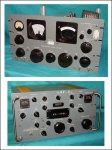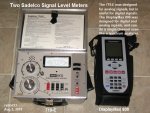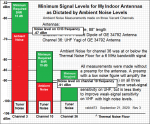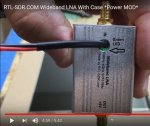You are using an out of date browser. It may not display this or other websites correctly.
You should upgrade or use an alternative browser.
You should upgrade or use an alternative browser.
RTL-SDR.COM Wideband Amplifier (Real World Results?)
- Thread starter Omega-TI
- Start date
- Status
- Not open for further replies.
Note on RTL-SDR Blog Wideband LNA (Bias Tee Powered) listing:About this, I'm assuming it's safe to use the bias-t when using the dipole software that comes with the device, correct? Sorry for the super basic question, but I'm assuming (possibly in error) that it's not a "shorted" antenna like a J-Pole. I think I read somewhere that there could be damaging results if used on the wrong type of antenna.
IMPORTANT ESD NOTE: If you use this LNA placed close to an outdoor antenna, please ensure that your antenna is sufficiently grounded. There is a fast ESD diode, and GDT on the LNA PCB for protection, but if the antenna is not grounded the effectiveness of ESD protection components will be severely reduced, and you run the risk of damaging the LNA.
Note on RTL-SDR Blog Wideband LNA (Bias Tee Powered) listing:
Honestly, my days of erecting towers and antennas is over, "I'm too old fer dat krap", besides I fully expect to downsize in the next year or two. Anything I do now will be an inside job and well hidden from view. Which is why the LNA is so appealing. My main concern is QRM from the PC and all the other electronics I have stuffed in the den.
I'm in a retirement facility on lockdown with an indoor antenna. There is a lot of electronic equipment in this building which makes the noise level very high. I can't even copy CW on HF unless I use a remote SDR.Anything I do now will be an inside job and well hidden from view. Which is why the LNA is so appealing. My main concern is QRM from the PC and all the other electronics I have stuffed in the den.

It's even worse on VHF-Low:


Last edited:
- Joined
- Dec 19, 2002
- Messages
- 2,563
I use Spectrumspy and an AirSpy R2 also..You have the gain set far too high in SpectrumSpy for it work properly. You are seeing what happens if you overload the Airspy and not the "noise floor".I'm in a retirement facility on lockdown with an indoor antenna. There is a lot of electronic equipment in this building which makes the noise level very high. I can't even copy CW on HF unless I use a remote SDR.
View attachment 109081
It's even worse on VHF-Low:
View attachment 109082
View attachment 109083
While I have a different LNA, I have the Nooelec Lana. It definitely performs differently with different antennas. With my outdoor discone I only see a 3db increase over the noise floor after reducing gain to bring the noise floor down to the same level, whereas with the sma telescoping whip that came with one of my dongles I get a 12db increase without significantly raising the noise floor. Tried the ducky antenna off my uniden, 5db increase with a nasty rise in the noise floor making it almost negligible. So far its done what I was hoping for, it added a little bit of gain while limiting some of the front end overload issues from the trains a block away, and the county so repeater 2 blocks away.
Thank you for your comment. I agree with you that properly setting the SDR RF gain is important. I don't agree with you that I have set the RF gain incorrectly. I increase the RF gain until just before the noise floor starts to rise. This gives the correct SNR and is well below the overload point. I use the same technique with the RTL-SDR.COM V3 dongle and SDR#. I was not using a preamp before the SDR. If I had been using a preamp or LNA, it would have been necessary to reduce the R2 RF gain.I use Spectrumspy and an AirSpy R2 also..You have the gain set far too high in SpectrumSpy for it work properly. You are seeing what happens if you overload the Airspy and not the "noise floor".
I have been doing antenna experiments since I was 8; I'm now 88 and still doing them. I have been a ham since the early 1950s and was a radio operator in the US Army in Germany (also a DL4). I have been helping posters with reception problems for the past 12 years on 5 forums with over 10,000 posts. I think I have a pretty good idea of how to adjust an RF gain control.
These are like the receivers I used in the Army in 1955.

This is the rig I used in the 1990s as a W4 mobile (DXCC):


Video
(I use VLC Media Player)
Download and play now:
2021-09-06 21-29-20AdjSSgain.mp4
Download now, play later:
https://www.dropbox.com/s/lr392jpjvc4w6vc/2021-09-06 21-29-20AdjSSgain.mp4?dl=1
- Joined
- Dec 19, 2002
- Messages
- 2,563
Thank you for your comment. I agree with you that properly setting the SDR RF gain is important. I don't agree with you that I have set the RF gain incorrectly. I increase the RF gain until just before the noise floor starts to rise. This gives the correct SNR and is well below the overload point. I use the same technique with the RTL-SDR.COM V3 dongle and SDR#. I was not using a preamp before the SDR. If I had been using a preamp or LNA, it would have been necessary to reduce the R2 RF gain.
I have been doing antenna experiments since I was 8; I'm now 88 and still doing them. I have been a ham since the early 1950s and was a radio operator in the US Army in Germany (also a DL4). I have been helping posters with reception problems for the past 12 years on 5 forums with over 10,000 posts. I think I have a pretty good idea of how to adjust an RF gain control.
...
I am only 68
The method that I use is the method suggested by Paolo Romani IZ1MLL in the SDR# Guide.I am only 68but been into radios since my teens. The issue is what you are calling the "noise floor". In the VHF-LO image, the noise floor is not visible as the gain is set too high for that frequency range. The needed setting to not overload the R2 varies with the frequency range being tuned but you used the same setting for what you posted.
https://airspy.com/downloads/SDRSharp_The_Guide_v2.2_ENG.pdf
The following adjustment procedure ensures that you get the maximum SNR (*) on what you receive while preserving dynamic range:
• Start with the RF gain set to the minimum level.
• Gradually increase the gain until the noise floor increases by about 5 dB.
• Check that increasing the gain does not also increase the SNR. Then increase the gain one notch higher and so on.

The TV signals on VHF-High are about the same strength as the TV signals on UHF, but the SNR of channel 11 is just barely enough for reliable reception (minimum required SNR is 15.5 dB) because the noise level is much higher on VHF-High.

The RF gain was set to 14 for both of the above scans. I will admit that 13 would have been a slightly more accurate setting, but it is nowhere near overload. The Airspy R2 has a 12-bit ADC (analog to digital converter, up to 16-bit with decimation) that gives a much greater dynamic range than the 8-bit ADC in the RTL-SDR V3 SDR. The R2 is much more resistant to overload than the RTL-SDR dongle.

The noise floor you see on the VHF-Low part of the scan is an accurate representation of the noise on VHF-Low. The noise on VHF-Low is extremely high because of electrical interference. I have actually measured the noise level with my signal level meters. It really is that bad.


This is the channel 3 indoor folded dipole I used:

This is what a channel 3 signal looked like:

This is a screenshot:

Note that the signal had to be at least -8 dBmV (-57 dBm) for reliable reception because of the extremely high noise level. On UHF with a quiet noise floor, a TV signal can be as weak as -35 dBmV (-84 dBm).
My RF gain setting agrees with the recommended method and gives the correct SNR indication of signals. My measurement method is correct.
- Joined
- Dec 19, 2002
- Messages
- 2,563
I use an R2 also (amoun others) and can tell you I see the same thing if I set the gain where you did for VHF. If I set it much lower, things look as they should. I have other receivers (RSP various models), R9500. R8600 etc. and none of them see that noise. For your 125 MHz 200 MHz BW, set the gain in SpectrumSpy at half the slider level that you did and show me that.
And something very important, pick up the R2 or slightly wiggle the wires, if you see a change in the "noise floor", the gain is so high, it is causing internal oscillation in the R2. I have seen that using the configuration that you are using.
And something very important, pick up the R2 or slightly wiggle the wires, if you see a change in the "noise floor", the gain is so high, it is causing internal oscillation in the R2. I have seen that using the configuration that you are using.
Last edited:
My ambient noise level is much higher than your noise level. The RF gain control on my R2 is set correctly. My location is not the same as your location.I use an R2 also (amoun others) and can tell you I see the same thing if I set the gain where you did for VHF. If I set it much lower, things look as they should. I have other receivers (RSP various models), R9500. R8600 etc. and none of them see that noise.
My noise level is so high on HF, I can't copy any ham bands with my RSP1A.
Maybe I will try to do a scan during the next power failure.
On the AM broadcast band, most of the stations are wiped out by noise on a battery operated radio:

The dBm scale on most SDRs is only relative, not absolute. The only SDRs that have a calibrated dBm scale are the RSPs by SDRplay.
Did you even look at the video I posted about how I adjusted the RF gain control on my R2?For your 125 MHz 200 MHz BW, set the gain in SpectrumSpy at half the slider level that you did and show me that.
There is nothing wrong with my R2.And something very important, pick up the R2 or slightly wiggle the wires, if you see a change in the "noise floor", the gain is so high, it is causing internal oscillation in the R2. I have seen that using the configuration that you are using.
I see no point in continuing this argument any longer.
I will adjust my R2 to suit the signals at my location; you can adjust your R2 however you want for your location.
Last edited:
Yes, that is what it is.Something about this "DC block" was bothering me, then the thought hit me, isn't this simply an inexpensive capacitor enclosed in a fancy RF shielded shell? Kinda spendy (if you ask me) if it's just a capacitive coupler.
View attachment 109132

That is a good quality DC block for about $20. You could buy a cheaper one for $5 to $10, or you could buy a lab-quality DC block for over $100; your choice.
- Joined
- Dec 19, 2002
- Messages
- 2,563
My ambient noise level is much higher than your noise level. The RF gain control on my R2 is set correctly. My location is not the same as your location.
My noise level is so high on HF, I can't copy any ham bands with my RSP1A.
Maybe I will try to do a scan during the next power failure.
On the AM broadcast band, most of the stations are wiped out by noise on a battery operated radio:
View attachment 109174
The dBm scale on most SDRs is only relative, not absolute. The only SDRs that have a calibrated dBm scale are the RSPs by SDRplay.
Did you even look at the video I posted about how I adjusted the RF gain control on my R2?
There is nothing wrong with my R2.
I see no point in continuing this argument any longer.
I will adjust my R2 to suit the signals at my location; you can adjust your R2 however you want for your location.
I have seen nothing to indicate your noise is higher as I can duplicate here what you have shown and I never said anything is wrong with your R2 other than like any receiver you can over drive it or cause it to have problems. I looked at your photos and understand but you are not responding to my simple request which might even make me agree with you. Yes, I do understand dBm on the AirSpy. Let me say again, I can duplicate what you show but at least in my case, that is not real noise as other receivers like my ICOM R9500 will show. I do not consider this an argument but a discussion comparing our different observations. When I do what you call the recommended method, for the 150 MHz area, I do not end up anywhere near where you have set the gain and see something entirely reasonable. Please set the gain where I suggested and show the screen capture. I might then agree that you have a noise problem.
Last edited:
I did post two measurements of my noise levels that I made with my signal level meter; perhaps you didn't notice them:I have seen nothing to indicate your noise is higher

Made some new measurements today with my SLM. I was moved to a different room after my wife died. Added CH3 folded dipole to VHF-High/UHF antenna with HLSJ. VHF-Low noise not as bad in this room, but it constantly varies a lot in strength.
Peak noise on channels not in use and minimum required signal, except for 7 and 11 which are in use:
Channel 2: -21.2dBmV = -70.2dBm + 15dB SNR = -55.2dBm Minimum Required Signal
Channel 3: -20.5dBmV = -69.5dBm + 15dB = -54.5dBm MRS
Channel 4: -21.8dBmV = -70.8dBm + 15dB = -55.8dBm MRS
Channel 5: -21.9dBmV = -70.9dBm + 15dB = -55.9dBm MRS
Channel 6: -18.5dBmV = -67.5dBm + 15dB = -52.5dBm MRS
142 MHz: -25.6dBmV = -74.6dBm peak noise (Freq of interest)
148 MHz: -28.5dBmV = -77.5dBm peak noise (Freq of interest)
(Now I know why I can't hear any 2m hams)
Channel 7 peak signal: -13.2dBmV= -62.2dBm
Channel 10: -33.1dBmV = -82.1dBm + 15dB = -67.1dBm MRS
Channel 11 peak signal: -15.2dBmV = -64.2dBm
What are the measurements for your noise levels?
I did a new scan with slightly lower R2 gain setting; looks a little better:

- Joined
- Dec 19, 2002
- Messages
- 2,563
Ok. You do have a noise problem. (On the one figure, in scrolling the screen, I think I missed some of the bar graph labels.) Your last plot is more what I expected to see. Have you tried to located the noise source (LED lights or light dimmers). I expect you have but have not found it. (On the one figure, in scrolling the screen, I think I missed some of the bar graph labels.)
This is a video of the VHF scan showing how much the noise varies:I have seen nothing to indicate your noise is higher..... Please set the gain where I suggested and show the screen capture. I might then agree that you have a noise problem.
Download and play now:
2021-09-09 21-53-23 VHF TV New Room.mp4
Download now, play later:
https://www.dropbox.com/s/ltkit9xxynm3qwu/2021-09-09 21-53-23 VHF TV New Room.mp4?dl=1
This is a screenshot of VHF-High and UHF.

Channel 34 noise: -56.3dBmV = -105.3dBm + 15dB for minimum SNR = -90.3dBm MRS
If your tuner has a Noise Figure of 6dB:
-90.3dBm + 6dB = -84.3dBm Minimum Required Signal
If you use a preamp with a low NF, you will probably be able to receive a weaker signal. You would be trading the tuner NF for the lower preamp NF.
This demonstrates how a low noise preamp can help if your ambient noise level is low, but can't help on VHF with a higher ambient noise level.
Last edited:
Thank you for your evaluation and encouraging response.Ok. You do have a noise problem. (On the one figure, in scrolling the screen, I think I missed some of the bar graph labels.) Your last plot is more what I expected to see.
The whole building is full of RFI sources. For example: IIRC, there are over 30 WiFi access points and many LED lights to conserve energy.Have you tried to located the noise source (LED lights or light dimmers). I expect you have but have not found it.
I hope to take my laptop, SLM, and antenna outside for some measurements.
- Status
- Not open for further replies.
Similar threads
- Replies
- 6
- Views
- 2K
- Replies
- 18
- Views
- 5K
- Locked
- Replies
- 18
- Views
- 4K
- Replies
- 41
- Views
- 12K





